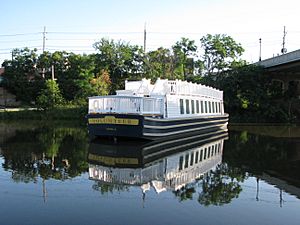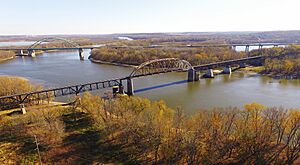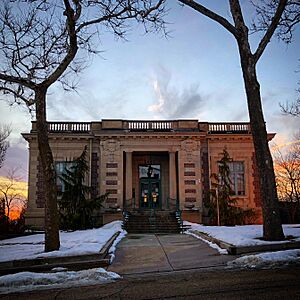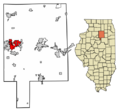LaSalle, Illinois facts for kids
Quick facts for kids
LaSalle
|
|
|---|---|
| LaSalle | |
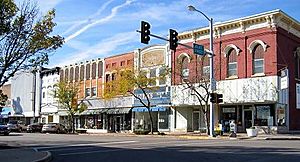
Downtown LaSalle, Illinois.
|
|
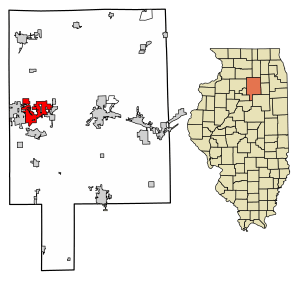
Location of LaSalle in LaSalle County, Illinois.
|
|
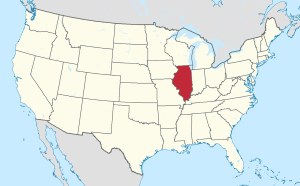
Location of Illinois in the United States
|
|
| Country | United States |
| State | Illinois |
| County | LaSalle |
| Townships | LaSalle, Utica, Peru, Waltham, Dimmick |
| Founded | 1852 |
| Area | |
| • Total | 13.57 sq mi (35.15 km2) |
| • Land | 13.46 sq mi (34.85 km2) |
| • Water | 0.12 sq mi (0.30 km2) |
| Elevation | 571 ft (174 m) |
| Population
(2020)
|
|
| • Total | 9,582 |
| • Density | 712.05/sq mi (274.92/km2) |
| Time zone | UTC−6 (CST) |
| • Summer (DST) | UTC−5 (CDT) |
| ZIP Code(s) |
61301
|
| Area codes | 815, 779 |
| FIPS code | 17-42184 |
| GNIS feature ID | 2395636 |
| Wikimedia Commons | LaSalle, Illinois |
LaSalle is a city in LaSalle County, Illinois, United States. It is located where two major highways, I-39 and I-80, meet. The city was named after Sieur de La Salle, a French explorer from the 1600s.
LaSalle started in 1837 and has grown quite a bit since then. It stretches from the Illinois River and Illinois and Michigan Canal to north of Interstate 80. To the west is the city of Peru, and to the east is North Utica. Starved Rock State Park is also nearby, about 5 miles (8 km) to the east.
In 2020, LaSalle had a population of 9,582 people. LaSalle and its neighbor, Peru, are often called the "Illinois Valley" area. They were once known as "Zinc City" because they were important in processing zinc in the early 1900s.
Contents
History of LaSalle
LaSalle is named after Robert de LaSalle, an early French explorer.
Canal Port: A Busy Waterway (1836–1933)
The idea for the Illinois and Michigan Canal came from French explorer Louis Joliet. Later, many people, including Abraham Lincoln, supported building it. The canal was 96 miles long and was built between 1836 and 1848.
When the canal was finished, Chicago became the eastern end, and LaSalle became the western end. LaSalle quickly became a very busy place. Boats from Chicago would arrive, and their goods would be moved to steamboats going to St. Louis and New Orleans. It was a meeting point for different cultures.
Imagine how busy the canal area was! Steamboats from New Orleans brought molasses, sugar, coffee, and fresh fruits. Canal boats from Chicago carried lumber, stoves, wagons, and new clothing styles. Local farmers brought their corn and wheat to be shipped. Travelers rushed to catch their next boat. Many hotels and stores opened to serve all these people.
Today, you can learn about this history at the LaSalle Canal Boat, the Volunteer.
Zinc City: An Industrial Hub (1858–1978)
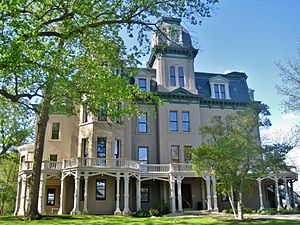
By the mid-1850s, LaSalle began mining the coal found under the city. The first coal mine shaft was finished in 1856. Soon, many other mining companies started. By 1884, there were six shafts, with the deepest going down 452 feet.
LaSalle's history changed when two immigrants arrived in 1858. Frederick William Matthiessen and Edward C. Hegeler chose LaSalle for a new zinc smelting plant. They picked LaSalle because it had lots of coal and great transportation from the canal and the Illinois Central Railroad. This was the first zinc plant in the United States. Before this, almost all zinc was imported.
Zinc was important for making brass and for fire-proofing. It was also used to prevent rust on iron and steel. When the first steel plant opened nearby in the 1870s, zinc became even more important. Within ten years, the Matthiessen and Hegeler Zinc Works became the biggest zinc producer in the country.
The Matthiessen and Hegeler families helped the community grow. They started other businesses like the LaSalle Machine and Tool Company and the Western Clock Co., which later became Westclox. Mary Hegeler married Dr. Paul Carus, who started the Open Court Publishing Company in 1887. This company helped bring Eastern ideas to the United States.
Matthiessen was also a generous person who served as Mayor of LaSalle from 1886 to 1895. He helped build the sewer system, the electric plant, and roads. He also gave money to LaSalle-Peru High School. In 1914, he created the Hygienic Institute to fight diseases. Matthiessen opened parts of his large estate, called Deer Park, to the public. In 1943, this land became Matthiessen State Park.
Today, you can visit the Hegeler-Carus Mansion to learn more about this history.
Little Reno: A Time of Entertainment (1933–1953)
After Prohibition ended in 1933, places that sold alcohol and offered gambling became very popular. Even though gambling was illegal, it grew in LaSalle. Many travelers came by car or train from Chicago for a fun Saturday night.
First Street, in the heart of LaSalle, was full of entertainment. The Kelly and Cawley liquor and gambling house was a main spot. LaSalle became known as "Little Reno" and had many clubs. From 1940 to 1950, LaSalle had between 60 and 80 places selling alcohol. This was a big part of the town's business. In 1953, a federal raid on Kelly and Cawley's ended this era.
Major Employers in LaSalle
Here are some of the largest businesses in LaSalle, employing over 100 people:
- J.C. Whitney: 313 employees
- Carus Chemical: 264 employees
- Illinois Veteran's Home: 200 employees
- LaSalle-Peru Township High School: 180 employees
- Illinois Cement Company: 148 employees
- News-Tribune: 101 employees
Geography and Natural Beauty
LaSalle is in the middle of a network of Illinois' largest cities. It is located where I-39 and I-80 cross. The city sits on a bluff above the Illinois River and the Illinois and Michigan Canal.
The area is known for its beautiful sandstone bluffs and rivers. This makes it a great place for hiking and outdoor adventures. LaSalle is very close to two popular Illinois parks: Starved Rock State Park and Matthiessen State Park. Matthiessen State Park was created from the land of LaSalle industrialist Frederick William Matthiessen.
LaSalle and Peru are the center of a community often called the Illinois Valley. Many small towns surround them, some formed as mining towns. These towns are spread across Bureau, Putnam, and LaSalle Counties.
Downtown LaSalle is a lively center for the community. It has many shops and businesses. It is one of the biggest employment areas in the region, with over 1,400 jobs.
LaSalle covers about 13.57 square miles (35.15 km2). Most of this area is land, with a small part being water.
Climate in LaSalle
| Climate data for LaSalle, Illinois | |||||||||||||
|---|---|---|---|---|---|---|---|---|---|---|---|---|---|
| Month | Jan | Feb | Mar | Apr | May | Jun | Jul | Aug | Sep | Oct | Nov | Dec | Year |
| Record high °F (°C) | 66 (19) |
72 (22) |
84 (29) |
91 (33) |
96 (36) |
101 (38) |
104 (40) |
103 (39) |
98 (37) |
91 (33) |
79 (26) |
70 (21) |
104 (40) |
| Mean daily maximum °F (°C) | 30 (−1) |
36 (2) |
48 (9) |
62 (17) |
73 (23) |
82 (28) |
85 (29) |
83 (28) |
77 (25) |
64 (18) |
49 (9) |
34 (1) |
60 (16) |
| Mean daily minimum °F (°C) | 14 (−10) |
18 (−8) |
28 (−2) |
39 (4) |
49 (9) |
59 (15) |
63 (17) |
61 (16) |
52 (11) |
41 (5) |
31 (−1) |
18 (−8) |
39 (4) |
| Record low °F (°C) | −26 (−32) |
−21 (−29) |
−8 (−22) |
13 (−11) |
25 (−4) |
37 (3) |
42 (6) |
40 (4) |
27 (−3) |
16 (−9) |
5 (−15) |
−21 (−29) |
−26 (−32) |
LaSalle experiences a range of temperatures throughout the year. Summers are warm, with average high temperatures in July around 85°F (29°C). Winters are cold, with average low temperatures in January around 14°F (-10°C). The city sees all four seasons, with spring and fall bringing milder weather.
Culture and Community Life
Arts and Entertainment
LaSalle is part of a lively arts community. This includes the Illinois Valley Symphony Orchestra and the Stage 212 community theater. You can find dance and music lessons for all ages at places like The Dance Center. Local artists often show their work in a gallery at the historic Westclox building.
The Jazz in the Street festival is held every September. It features popular local bands, including jazz bands from nearby colleges.
Tourism and Local Attractions
Many visitors come to the LaSalle area because of its beautiful state parks. These include Starved Rock State Park, Matthiessen State Park, and Buffalo Rock State Park. The I&M Canal National Heritage Area is also a popular spot.
There are several museums and historical sites to explore:
- I&M Canal National Heritage Area Visitor Center & LaSalle Canal Boat: Here, you can take a ride on The Volunteer, an 1880s replica canal boat pulled by mules. Guides dressed in old-fashioned clothes share stories about life on the canal.
- Hegeler-Carus Mansion: This grand Victorian home was built in 1874. It has 57 rooms, 10 fireplaces, and even the oldest private gym in America! The mansion is filled with beautiful details like hand-painted walls and old chandeliers.
- Westclox Museum: Learn about the history of the famous Westclox company.
- LaSalle County Historical Society Museum: Discover more about the local history of LaSalle County.
- Starved Rock Visitor Center: Get information about the famous state park.
- Illinois Waterway Visitor Center: Learn about the Illinois River and its importance.
- Wild Bill Hickok Memorial: A memorial to a famous figure from the Old West.
Downtown LaSalle is a historic area with many unique shops and boutiques. LaSalle also has several buildings listed on the National Register of Historic Places, like the Hotel Kaskaskia and the Hegeler-Carus Mansion. The Hegeler-Carus Mansion is even a National Historic Landmark!
Sports and Recreation
LaSalle has a strong Little League baseball program with nearly 30 teams. There is also a youth football league for younger players.
The city once had a minor league baseball team called the LaSalle Blue Sox in 1914.
Local Media
The area has three radio stations: WLPO, WAJK, and WLWF. The local newspaper, the NewsTribune, serves the community. You can also find many Chicago newspapers here.
Education in LaSalle
Students in grades 9-12 attend LaSalle-Peru Township High School. Younger students, from Pre-Kindergarten to 8th grade, go to schools in the LaSalle Elementary School District 122. There is also Trinity Catholic Academy.
Population and People
| Historical population | |||
|---|---|---|---|
| Census | Pop. | %± | |
| 1860 | 3,993 | — | |
| 1870 | 5,200 | 30.2% | |
| 1880 | 7,847 | 50.9% | |
| 1890 | 9,855 | 25.6% | |
| 1900 | 10,446 | 6.0% | |
| 1910 | 11,537 | 10.4% | |
| 1920 | 13,050 | 13.1% | |
| 1930 | 13,149 | 0.8% | |
| 1940 | 12,812 | −2.6% | |
| 1950 | 12,083 | −5.7% | |
| 1960 | 11,897 | −1.5% | |
| 1970 | 10,736 | −9.8% | |
| 1980 | 10,341 | −3.7% | |
| 1990 | 9,090 | −12.1% | |
| 2000 | 9,470 | 4.2% | |
| 2010 | 9,609 | 1.5% | |
| 2020 | 9,582 | −0.3% | |
| Decennial US Census | |||
As of the 2020 census, LaSalle had 9,582 people living in the city. There were 3,758 households. About 26.6% of households had children under 18. The average household had 2.34 people.
The population of LaSalle is diverse. About 79% of residents are White, and 18% are Hispanic or Latino. The median age in the city was 38.6 years old.
The median income for a household in LaSalle was $53,208. About 16.7% of the population lived below the poverty line.
Transportation in LaSalle
LaSalle is a key transportation hub. It is located at the intersection of two major interstates: Interstate 80 and Interstate 39. Other important routes like Illinois Route 351 and US Route 51 also pass through the city.
Several train lines run through LaSalle, including the CSX New Rock Subdivision. While there isn't a local bus system, you can find intercity bus service in nearby Peru through Burlington Trailways.
Places to Visit
- Hegeler Carus Mansion
- LaSalle Canal Boat
- LaSalle Speedway
- Peru-LaSalle Station
Notable People from LaSalle
Many interesting people have connections to LaSalle:
- James T. Aubrey, Jr. (1918–1994), a television and film executive, was born here.
- H. R. Baukhage (1889–1976), a newsman, was born in LaSalle.
- Heinie Berger (1882–1954), a baseball pitcher, was born here.
- Timothy Blackstone (1829–1900), the second mayor of LaSalle.
- Alexander Campbell (1814–1898), LaSalle's first mayor.
- Paul Carus (1852‑1919), an editor who lived in the Hegeler Carus Mansion.
- Hal Cherne (1907–1983), an offensive lineman for the Boston Redskins, was born here.
- Lynden Evans (1858–1926), a U.S. Representative, was born in LaSalle.
- John Fitzpatrick (1904–1990), a baseball coach, was born here.
- Mike Goff, an offensive guard for the Kansas City Chiefs, attended LaSalle-Peru High School.
- Edward C. Hegeler (1835–1910), a manufacturer who built the Hegeler Carus Mansion.
- Thomas L. Kilbride, an Illinois Supreme Court Justice, was born here.
- Rick Kolowski (born 1944), a Nebraska state legislator.
- Harry Lachman (1886-1975), an artist and film director, was born here.
- Albert C. Martin, Sr. (1879–1960), an architect and engineer, was born here.
- Frederick William Matthiessen (1835–1918), a generous industrialist and former Mayor of LaSalle.
- Philip Godfrey Reinhard, a federal judge, was born here.
- Daisetz Teitaro Suzuki (1870–1966), a famous author of Buddhist teachings, worked at the Hegeler Carus Mansion.
- Walt Tauscher (1901–1992), a baseball pitcher, was born here.
- Luke Yaklich, a college basketball coach, attended LaSalle-Peru High School.
Images for kids
See also
 In Spanish: LaSalle (Illinois) para niños
In Spanish: LaSalle (Illinois) para niños


